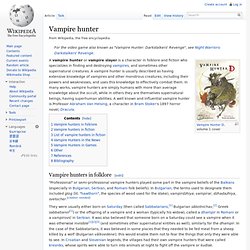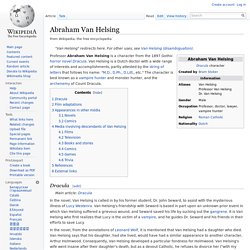

About Vampires. Vampires are mythological or folkloric beings who endure their undead life by feeding on the life of others usually in the form of blood or spiritual essence.

Regardless of the victims being either dead or undead. In folkloric tales, vampires often visited friends and loved ones to either cause mischief or bring about their deaths. They were often seen wearing shrouds and described as bloated versions of their former selves. They were also either pinkish/bronzed or dark colored in looks. For this reason, modern vampires beginning in the early 19th century are often portrayed as skinny and pale. Famous Vampires Famous Vampire TV Series Buffy the Vampire Slayer (1997) Buffy the Vampire Slayer (Sarah Michelle Gellar) is gifted with heightened strength and speed so that she can defend the human race against vampires. Angel (1999) Angel is the spinoff from Buffy the Vampire Slayer and focuses on the trials of Angel. True Blood (2008) The Vampire Diaries (2009) Forever Knight (1992) Moonlight (2007) Vampire. Vampires are mythical beings who subsist by feeding on the life essence (generally in the form of blood) of living creatures In folkloric tales, undead vampires often visited loved ones and caused mischief or deaths in the neighbourhoods they inhabited when they were alive.

They wore shrouds and were often described as bloated and of ruddy or dark countenance, markedly different from today's gaunt, pale vampire which dates from the early 1800s. Although vampiric entities have been recorded in most cultures, the term vampire was not popularised until the early 18th century, after an influx of vampire superstition into Western Europe from areas where vampire legends were frequent, such as the Balkans and Eastern Europe,[1] although local variants were also known by different names, such as vrykolakas in Greece and strigoi in Romania.
Etymology Folk beliefs Description and common attributes Creating vampires. Vampire hunter. A vampire hunter or vampire slayer is a character in folklore and fiction who specializes in finding and destroying vampires, and sometimes other supernatural creatures.

A vampire hunter is usually described as having extensive knowledge of vampires and other monstrous creatures, including their powers and weaknesses, and uses this knowledge to effectively combat them. In many works, vampire hunters are simply humans with more than average knowledge about the occult, while in others they are themselves supernatural beings, having superhuman abilities. A well known and influential vampire hunter is Professor Abraham Van Helsing, a character in Bram Stoker's 1897 horror novel, Dracula. Abraham Van Helsing. Professor Abraham Van Helsing is a character from the 1897 Gothic horror novel Dracula.

Van Helsing is a Dutch doctor with a wide range of interests and accomplishments, partly attested by the string of letters that follows his name: "M.D., D.Ph., D.Litt., etc. " The character is best known as a vampire hunter and monster hunter, and the archenemy of Count Dracula. Dracula[edit] In the novel, Van Helsing is called in by his former student, Dr. John Seward, to assist with the mysterious illness of Lucy Westenra. Dhampir. A Dhampir in Balkan folklore is the child of a vampire and a human.

The term is sometimes spelled dhampyre, dhamphir, or dhampyr. Dhampir powers are similar to those of vampires, but without the usual weaknesses.[1] In recent vampire fiction, Dhampir refers to any hybrid of one human and one vampire parent; they are half-breeds, not vampires themselves. Etymology[edit] Vampire folklore by region. Vlad the Impaler. Vlad III, Prince of Wallachia (1431–1476/77), was a member of the House of Drăculești, a branch of the House of Basarab, also known by his patronymic name: Dracula.

He was posthumously dubbed Vlad the Impaler (Romanian: Vlad Țepeș pronounced [ˈvlad ˈt͡sepeʃ]), and was a three-time Voivode of Wallachia, ruling mainly from 1456 to 1462, the period of the incipient Ottoman conquest of the Balkans. His father, Vlad II Dracul, was a member of the Order of the Dragon, which was founded to protect Christianity in Eastern Europe. Vlad III is revered as a folk hero in Romania as well as other parts of Europe for his protection of the Romanian population both south and north of the Danube.
Elizabeth Báthory. Countess Elizabeth Báthory de Ecsed (Báthory Erzsébet in Hungarian, Alžbeta Bátoriová in Slovak; 8 August 1560 – 21 August 1614) was a countess from the renowned Báthory family of nobility in the Kingdom of Hungary. She has been labelled the most prolific female serial killer in history and is remembered as the "Blood Countess", though the precise number of victims is debated. After her husband Ferenc Nádasdy's death, she and four collaborators were accused of torturing and killing hundreds of girls, with one witness attributing to them over 650 victims, though the number for which they were convicted was 80.[4] Due to her rank, Elizabeth herself was neither tried nor convicted, but promptly imprisoned upon her arrest in December 1610 within Csejte Castle, Upper Hungary, now in Slovakia, where she remained immured in a set of rooms until her death four years later.
Life[edit] Early years[edit] Ecsed, the lake and the old castle. Married life[edit] Accusation[edit] Investigation[edit]